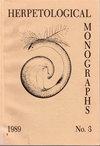Taxonomic Revision of Philippine Sun Skinks (Reptilia: Squamata: Scincidae: Eutropis), and Descriptions of Eight New Species
IF 1
2区 生物学
Q3 ZOOLOGY
引用次数: 6
Abstract
Abstract: Species descriptions of reptiles historically have relied exclusively on the use of morphological data; however, these external, phenotypic data do not always co-vary with lineage divergence. Consequently, it has become increasingly clear that species diversity has been underestimated in many evolutionary radiations. With the use of an integrative approach, we examined the genetic and morphological diversity present in a nearly endemic Philippine radiation of Eutropis. Results demonstrated that current taxonomy does not reflect evolutionary history and that in many cases, morphological divergence has become decoupled from genetic divergence. As a consequence, species diversity is significantly underestimated. Here, we rectify the major taxonomic problems present in Philippine Eutropis by providing formal descriptions for eight new species. Three of the four new species in the E. multicarinata species complex are sympatric with (and have long been confused with) previously described subspecies (which we also elevate to full species here). The fourth species is endemic to the Caroline Islands, clearly derived from a long-distance dispersal event from the Philippines. The new species in the E. indeprensa species complex are allopatrically or parapatrically distributed across the archipelago. In contrast to the last review of Philippine Eutropis, which suggested the endemic radiation was composed of five species (one of which was composed of two subspecies), we demonstrate that this group includes at least 14 distinct evolutionary lineages, with potential for additional diversity to be discovered pending further study.文章标题菲律宾太阳石龙子(爬行纲:鳞目:剑齿虎科)分类修订及八新种描述
摘要:爬行动物的物种描述在历史上完全依赖于形态学数据的使用;然而,这些外部的表型数据并不总是与谱系差异一致。因此,越来越明显的是,在许多进化辐射中,物种多样性被低估了。采用综合方法,我们检测了菲律宾一种几乎地方性的Eutropis辐射中存在的遗传和形态多样性。结果表明,目前的分类学并不能反映进化史,在许多情况下,形态分化已经与遗传分化脱钩。因此,物种多样性被严重低估。在这里,我们通过对八个新物种的正式描述,纠正了菲律宾真热带植物中存在的主要分类学问题。在E.multicarnata物种复合体中的四个新物种中,有三个与之前描述的亚种(我们在这里也将其提升为完整物种)同域(长期以来一直被混淆)。第四个物种是加罗林群岛的特有物种,显然源于菲律宾的一次远距离传播事件。E.indeprensa物种复合体中的新物种分布在整个群岛的异地或旁系。上一次对菲律宾Eutropis的综述表明,当地辐射由五个物种组成(其中一个由两个亚种组成),与此相反,我们证明该类群至少包括14个不同的进化谱系,在进一步研究之前,可能会发现更多的多样性。
本文章由计算机程序翻译,如有差异,请以英文原文为准。
求助全文
约1分钟内获得全文
求助全文
来源期刊

Herpetological Monographs
生物-动物学
CiteScore
5.40
自引率
0.00%
发文量
2
审稿时长
>12 weeks
期刊介绍:
Since 1982, Herpetological Monographs has been dedicated to original research about the biology, diversity, systematics and evolution of amphibians and reptiles. Herpetological Monographs is published annually as a supplement to Herpetologica and contains long research papers, manuscripts and special symposia that synthesize the latest scientific discoveries.
 求助内容:
求助内容: 应助结果提醒方式:
应助结果提醒方式:


